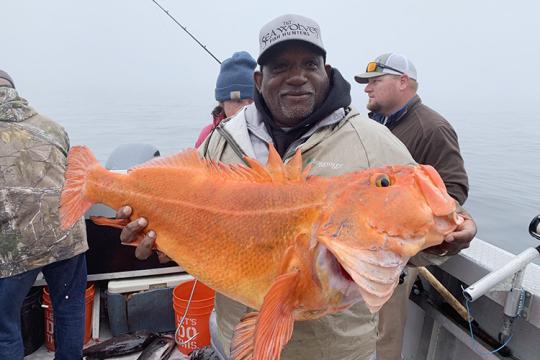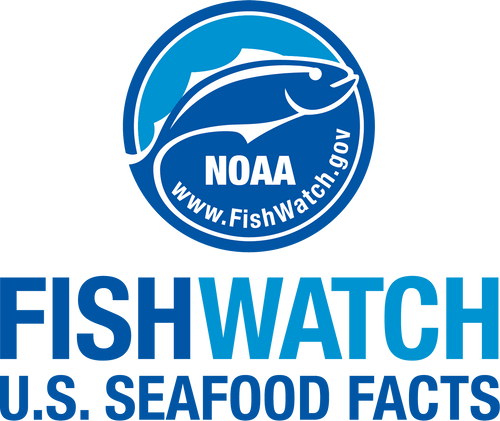 Pacific blue marlin. Credit: Ken Neill
Pacific blue marlin. Credit: Ken Neill
Pacific blue marlin. Credit: Ken Neill
About the Species
 Pacific blue marlin. Credit: Ken Neill
Pacific blue marlin. Credit: Ken Neill
Pacific blue marlin. Credit: Ken Neill
U.S. wild-caught Pacific blue marlin is a smart seafood choice because it is sustainably managed and responsibly harvested under U.S. regulations.

Population
The stock is not overfished.

Fishing Rate
Not subject to overfishing.

Habitat Impact
Gear used to harvest blue marlin rarely contacts the ocean floor, so habitat impacts are minimal.

Bycatch
Regulations are in place to minimize bycatch in the tuna and swordfish fisheries, which incidentally catch the most commercially available blue marlin.
Population Status
- According to the 2021 stock assessment, Pacific blue marlin is not overfished and not subject to overfishing. Summary stock assessment information can be found on Stock SMART.
- Population assessments for Pacific blue marlin are conducted by the Billfish Working Group, a division of the International Scientific Committee for Tuna and Tuna-Like Species in the North Pacific Ocean (ISC). NOAA Fisheries scientists participate in the ISC assessment and contribute relevant U.S. fishery data.
Appearance
- Blue marlin are deep cobalt blue on top and silvery white on the bottom.
- They have a pronounced dorsal fin and a long, spear-shaped upper jaw (bill).
Biology
- Blue marlin may grow to be more than 12 feet long and may weigh up to 2,000 pounds.
- Female blue marlin grow larger than males and may live 20 years.
- Male blue marlin reach 7 feet in length and may live up to 10 years.
- They grow fast and may reach 3 to 6 feet in the first 1 to 2 years of life.
- Males mature around 2 years old, and females mature between 3 to 4 years old.
- Blue marlin spawn between May and September.
- They eat mostly tuna and other open water fishes.
Where They Live
Range
- Blue marlin live throughout tropical and subtropical waters of the Indian, Pacific, and Atlantic Oceans.
Habitat
- Blue marlin prefer warm surface waters that are well mixed by surface winds and are uniform in temperature and salinity. They are considered the most tropical of all billfishes.
- They spend all of their time in the water column, frequently moving between the surface and a depth of 100 meters. Depth distribution is limited by low water temperature and low oxygen levels.
Fishery Management
- NOAA Fisheries and the Western Pacific Fishery Management Council manage the Pacific blue marlin fishery.
- Managed under the Fishery Ecosystem Plan for Pacific Pelagic Fisheries of the Western Pacific Region:
- Entry to this fishery is limited to a maximum of 164 vessels.
- Permits and logbooks are required.
- Observers are required on all Hawaii-based longline vessels.
- NOAA Fisheries vessel monitoring system program requires longline boats to be equipped with a satellite transponder that provides real-time vessel position updates and tracks vessel movements.
- Longlines are prohibited in certain areas to protect endangered Hawaiian monk seals and reduce the potential for gear conflicts and localized stock depletion.
- Vessels operating under longline general permits must carry special gear to release incidentally hooked or entangled sea turtles.
- Fishing gear requirements apply to all Hawaii longline limited access permitted vessels. The requirements may change depending on type of fishing trip, location of fishing, and how the gear is set.
- Management of highly migratory species, like Pacific blue marlin, is complicated because the species migrate thousands of miles across international boundaries and are fished by many nations.
- Effective conservation and management of this resource requires international cooperation as well as strong domestic management.
- Two organizations, the Inter-American Tropical Tuna Commission (IATTC) and the Western and Central Pacific Fisheries Commission (WCPFC) manage this fishery internationally.
- These Commissions rely on the scientific advice of their staff and the analyses of the International Scientific Committee for Tuna and Tuna-like Species in the North Pacific (ISC) to develop and adopt international resolutions for conservation and management measures.
- Working with the U.S. Department of State, NOAA Fisheries domestically implements these conservation and management measures.
Harvest
- Commercial fishery:
- Marlin are primarily caught incidentally in pelagic longline commercial fisheries for tuna and swordfish. They are also a popular target fish for recreational fishermen.
- In 2020, commercial landings of Pacific blue marlin from the waters around Hawaii totaled 900,000 pounds and were valued at $1.1 million, according to the NOAA Fisheries commercial fishing landings database.
- The Billfish Conservation Act, along with existing billfish regulations, prohibits the sale and commercial possession of billfish and billfish products. However, those that are caught in Hawaii and the Pacific Insular Areas (which includes American Samoa, Guam, and the Northern Mariana Islands) are exempt and can be sold.
- Gear types, habitat impacts, and bycatch:
- U.S. pelagic longline fishermen who target tuna and swordfish may incidentally catch blue marlin.
- Fishing gear used to catch tuna and swordfish rarely contacts the seafloor so habitat impacts are minimal.
- Restrictions on the type of fishing gear that can be used, and prohibitions on fishing in certain areas, minimize impacts on protected species.
- Interactions with protected species such as sea turtles, marine mammals, and seabirds in these fisheries are rare and survival rates are estimated to be high for all gear types.
- Longline fishermen are trained in safe handling and release techniques for sea turtles, seabirds, and marine mammals, and they carry and use specific equipment for handling and releasing these animals.
- Scientists and managers continue to monitor bycatch in these fisheries through logbooks and fishery observer programs.
- Recreational fishery:
- Blue marlin are a favorite target for recreational fishermen, as the fish tend to put up an incredible fight when hooked.
- In 2022, recreational anglers landed 1.3 million pounds of blue marlin, according to the NOAA Fisheries recreational fishing landings database.
- Hawaii hosts one of the largest billfish tournaments in the United States. Most fish caught in recreational tournaments are tagged and released.
- There is little bycatch associated with the recreational fishery.
Scientific Classification
| Kingdom | Animalia |
|---|---|
| Phylum | Chordata |
| Class | Actinopterygii |
| Order | Istiophoriformes |
| Family | Istiophoridae |
| Genus | Makaira |
| Species | nigricans |
Last updated by NOAA Fisheries on 03/05/2025
Featured News


U.S Achievements at ICCAT Include Measure to Address Overfishing of Marlin

Seafood Facts

Is Pacific Blue Marlin Sustainable?
U.S. wild-caught Pacific blue marlin is a smart seafood choice because it is sustainably managed and responsibly harvested under U.S. regulations.
Availability
From June through October.
Source
U.S. wild-caught from waters around Hawaii, other U.S. Pacific Islands, and the high seas.
Taste
Rich, full flavor.
Texture
Firm and meaty, similar to swordfish.
Color
Light golden-orange when raw, turns off-white when cooked.
Health Benefits
Blue marlin is low in saturated fat and sodium, and is a good source of vitamin B12, vitamin B6, selenium, niacin, and protein.
Nutrition Facts
Servings: 1; Serving Weight: 113 g; Calories: 120; Protein: 29 g; Total Fat: 0.5 g; Total Saturated Fatty Acids: 0 g; Carbohydrate: 0 g; Total Sugars: 0 g; Total Dietary Fiber: 0 g; Cholesterol: 35 mg; Selenium: 110 mcg; Sodium: 45 mgMore Information
Last updated by NOAA Fisheries on 03/05/2025
Seafood News
 Fresh-caught taʻape on ice. Credit: Conservation International Hawaiʻi.
Fresh-caught taʻape on ice. Credit: Conservation International Hawaiʻi.
Reducing Waste and Feeding Communities in Hawaiʻi with a Whole Fish Approach
 Chef Tyler Hadfield’s Curried Skate Wings with Tomato-Masala Chutney
Chef Tyler Hadfield’s Curried Skate Wings with Tomato-Masala Chutney
Ring In the New Year With These Crowd-Favorite Seafood Recipes
 NOAA Fisheries, in collaboration with Blue Ocean Mariculture, is conducting a multi-year pilot study to evaluate observational methods and tools for studying Hawaiian monk seal behavior. Courtesy of Blue Ocean Mariculture
NOAA Fisheries, in collaboration with Blue Ocean Mariculture, is conducting a multi-year pilot study to evaluate observational methods and tools for studying Hawaiian monk seal behavior. Courtesy of Blue Ocean Mariculture
AI Meets Aquaculture to Study Hawaiian Monk Seal Interactions With Net Pens
 Tonya Wick aboard a fishing vessel at sea in 1998. Photo courtesy of Tonya Wick
Tonya Wick aboard a fishing vessel at sea in 1998. Photo courtesy of Tonya Wick
Documents
2017 Billfish Newsletter
The annual Billfish Newsletter communicates the results of cooperative efforts between fishery…
2016 Billfish Newsletter
The annual Billfish Newsletter shares the results of cooperative efforts between fishery scientists…
Data & Maps
American Samoa Longline Logbook Reports 2023
Logbook summary reports for the 2023 calendar year.
American Samoa Longline Logbook Reports 2022
Logbook summary reports for the 2022 calendar year.
Hawaii and California Longline Logbook Reports 2022
Logbook summary reports for the 2022 calendar year.
Hawaii and California Longline Logbook Reports 2021
Logbook summary reports for the 2021 calendar year.
Research
Relative Impacts of Simultaneous Stressors on a Pelagic Marine Ecosystem
Model suggests that due to climate change, a decline in the yield of Hawaii's longline fishery may…
Last updated by NOAA Fisheries on 03/05/2025



